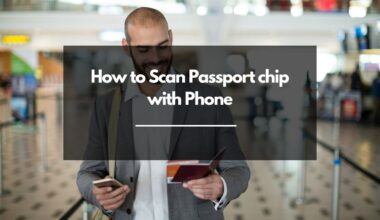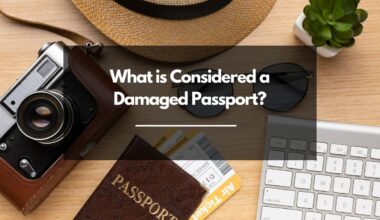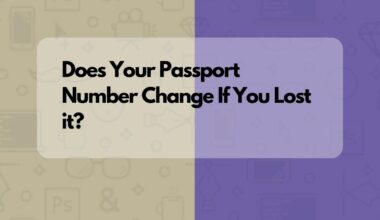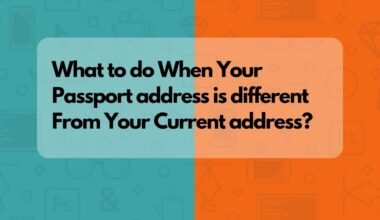As an Amazon Associate, I earn a small commission from qualifying purchases. Learn more about this.
If you find out that your passport is flagged, it’s not the end of the world. There are steps you can take to fix this issue. Remember, these flags are not removed automatically; you need to be proactive.
But most importantly, the actions you take are dependent on what resulted to the flagging of your passport.
As a result, our fixes are directed based on the specific reasons that resulted to these.
1. Report Lost or Stolen Passports:
If your passport gets flagged because it was reported lost or stolen, the first thing to do is to contact the authorities that handle passports in your country.
This could be a passport office or a national police department. Let them know what happened as soon as you can.
They will guide you on what steps to follow.
This usually involves filling out some forms and possibly providing additional information about when and where you think the passport was lost or stolen.
After you report it, the authorities will start to work on your case.
They might ask you for more details or documents to help them understand what happened. It’s important to give them all the information they need and to answer their questions.
Once they have everything they need and they’re satisfied that your passport was really lost or stolen, they will remove the flag from your passport.
This means your passport will no longer have a warning or alert on it.
2. Address Flags Due to Errors:
Sometimes, your passport might be flagged by mistake.
This can happen for various reasons, like a mix-up in names or a technical error in the system.
If you think this has happened to you, it’s important to act fast.
First, get in touch with the passport office or the authority that deals with passports in your country.
Explain to them that you believe your passport has been wrongly flagged.
Be clear and calm when you talk to them. They are there to help you, and understanding your situation is the first step in solving it.
Next, gather any documents or proof that can support your claim.
This might include your travel history, identity documents, or any other paperwork that shows there’s been a mistake.
Sometimes, you might need to write a letter or fill out a form explaining your situation.
When you provide these documents, make sure they are clear and easy to read.
If you need help understanding what documents to give, don’t hesitate to ask the authorities for guidance. They can tell you exactly what they need to see.
After you submit your proof, the authorities will review your case.
They will check the details and see if there was indeed an error.
If they find that the flagging was a mistake, they will remove the flag from your passport.
This process can take some time, so be patient. Keep in touch with the authorities and follow up if needed.
3. Request a Redress Number:
If you often face extra checks at airports or borders (like TSA checkpoints), and you think it’s because of a mistake, you can ask for something called a “Redress Number.”
This is done through a program by the Department of Homeland Security (DHS) called the Traveler Redress Inquiry Program (TRIP).
Here’s how you do it:
- Apply for a Redress Number: Go to the TRIP website and fill out a form to apply. You will need to give some details about yourself and your travel history. This helps DHS understand your situation better.
- Provide Documents: You might need to give them copies of documents like your passport or driver’s license. These documents help prove who you are and support your case.
- Wait for a Review: After you apply, DHS will look into your case. They will check if your name is similar to someone on a watch list or if there has been some other mix-up. This review can take some time, so be patient.
- Get Your Redress Number: If DHS finds that you have been flagged by mistake, they will give you a Redress Number. This number is important. When you book flights or go through security checks, you can use this number. It tells the officers that your case has been reviewed and cleared, which should make your travel easier and reduce extra checks.
Keep in mind that getting a Redress Number doesn’t mean you will never face extra security checks again.
But it does help in showing that you have been checked and cleared by DHS, and this can make your travel smoother.
4. Consult Legal or Immigration Experts:
Sometimes, the reason your passport is flagged can be complex, like issues with the law or security matters.
In such cases, it’s wise to talk to experts who know a lot about legal or immigration rules.
These experts could be lawyers or advisors who specialize in passport and travel laws.
- Find the Right Expert: Look for a lawyer or advisor who has experience with passport issues. You can search online or ask friends and family for recommendations.
- Explain Your Situation: When you meet with the expert, tell them everything about your case. Share details about why your passport was flagged, any letters or emails you received about it, and your travel history. The more they know, the better they can help you.
- Follow Their Advice: These experts will give you advice on what to do next. They might suggest filling out certain forms, writing letters, or even going to court in some cases. It’s important to follow their advice closely.
- Stay in Touch with Them: Keep in contact with the expert as you work through the issue. They can help you if new problems come up or if you need more advice.
5. SEVIS-Related Flags for Students with F, M, or J Visas:
If you’re a student in the U.S. on an F, M, or J visa, a flag on your SEVIS record might cause your passport to be flagged. Here’s what you can do:
- Understand SEVIS and Your Record: SEVIS, or the Student and Exchange Visitor Information System, is a system that keeps track of students and exchange visitors in the U.S. It stores information like your passport details, U.S. visa, and your entry and exit from the U.S. If there’s a problem in your SEVIS record, it can affect your passport.
- Contact Your Designated School Official (DSO): If you think there’s a flag on your SEVIS record, talk to your DSO first. They are there to help you with SEVIS-related issues. They can check your record and add any missing information. However, they can’t change data that comes from other government databases. If something is wrong there, your DSO will need to call the SEVP Resource Center to get it corrected.
- Request Corrections or Data Fixes: If there are mistakes in your SEVIS record, your DSO can request corrections. This is important because wrong information in SEVIS can affect your status or eligibility for benefits like work authorization. Your DSO has options to correct your SEVIS records depending on the situation.
- What If Your SEVIS Record is Terminated? Sometimes, your SEVIS record might be terminated. This can happen for many reasons, like if you change your student status or if you didn’t follow school or visa rules. If your DSO thinks your SEVIS record was wrongly terminated, they can request a correction. But if the termination was correct and you want to keep studying in the U.S., you might need to apply for reinstatement with U.S. Citizenship and Immigration Services (USCIS).
- Keep All Your Documents and Information Updated: Always make sure your DSO has your current information. This includes your passport details, current address, and any changes in your study plans. Keeping your information updated helps avoid problems with your SEVIS record.
- Be Prepared at the Port of Entry: If you’re traveling to the U.S. and there’s a flag on your SEVIS record, be ready to explain the situation. Bring documents that show you’re resolving the issue, like emails from your DSO or a printout of your SEVIS record. It’s also a good idea to have the contact information of your DSO with you in case you need it at the border.
- Regular Check-ins With Your DSO: Regularly meet with your DSO to ensure that your SEVIS record is accurate. They will guide you on maintaining your status and can help you understand and resolve any issues that might arise
Conclusion
A flagged passport can be a significant hurdle in your travel plans, but it’s often a solvable issue.
Have you ever experienced issues with a flagged passport? Share your story in the comments below and let us know how you resolved it. Your experience might help fellow travelers in similar situations.







